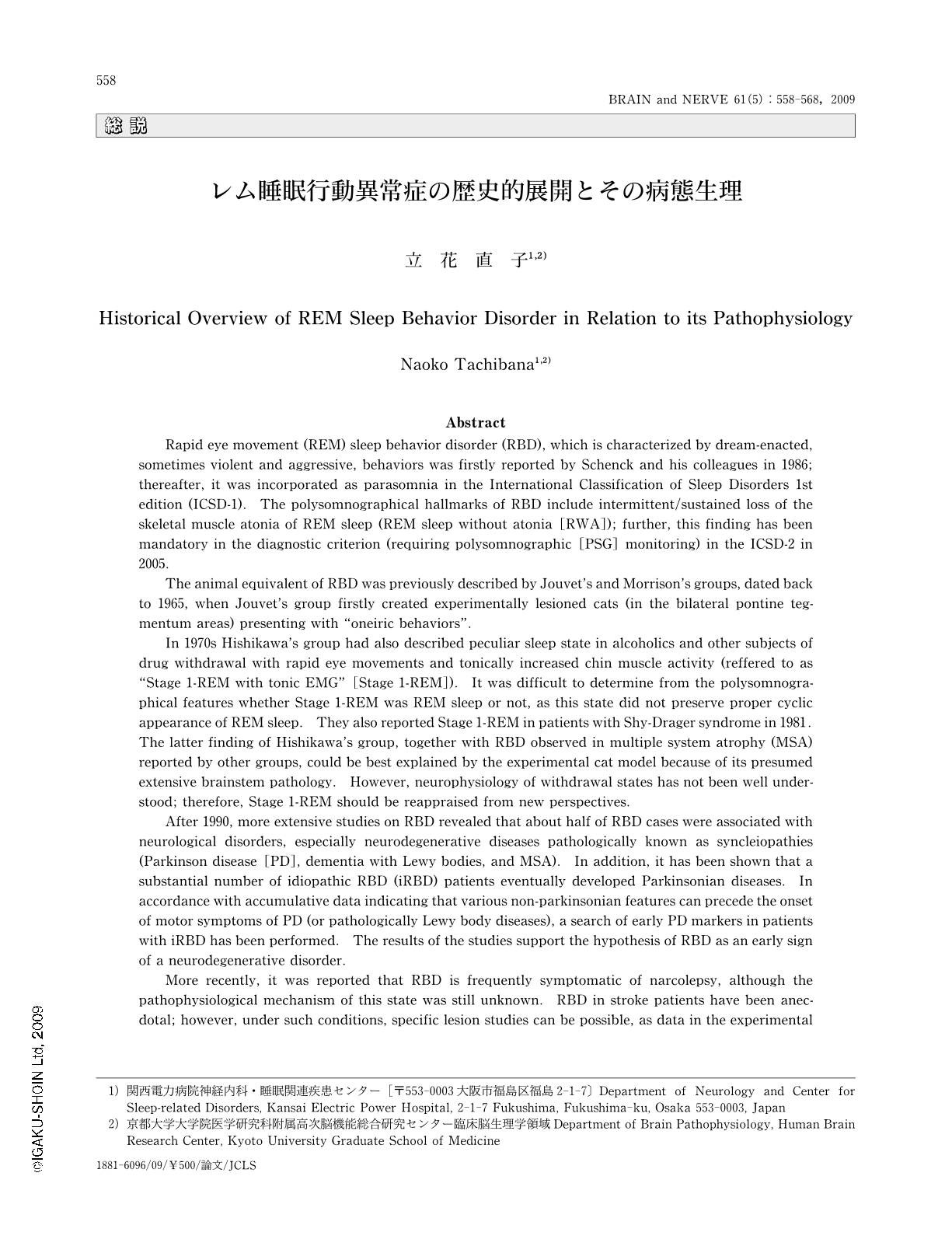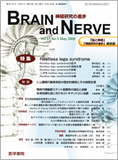Japanese
English
- 有料閲覧
- Abstract 文献概要
- 1ページ目 Look Inside
- 参考文献 Reference
はじめに
レム睡眠行動異常症[rapid eye movement (REM) sleep behavior disorder:RBD]は,レム睡眠において夢内容と一致した運動や行動(発声や発語を含む)が起こる睡眠随伴症(パラソムニア)であり,睡眠医学の領域では,レム睡眠の発現機構の観点から興味深い疾患(病態)として臨床家と研究者の両方から注目されていた。一方,最近になって,種々の神経変性疾患,特にパーキンソン病(Parkinson disease:PD)やレヴィ小体型認知症(dementia with Lewy bodies:DLB),多系統萎縮症(multiple system atrophy:MSA)の発症前に認められることから神経内科領域でも関心を集めつつある1)。RBDの疾患概念はいまだ発展途上であり,1つの疾患単位として取り扱えるのか,あるいは,ある種の基礎疾患を持つ患者に起こる睡眠関連症状として捉えるべきなのか,睡眠医学と神経学との間で十分な検討がなされておらず,RBDの病態生理を今後さらに解明していくには,これまでの歴史的な流れを知っておく必要がある。本稿では,RBDの発見とそれ以前の前史,さらに発見後の疾患概念の展開についてまとめ,今後の進むべき方向について私見を述べた。
Abstract
Rapid eye movement (REM) sleep behavior disorder (RBD), which is characterized by dream-enacted, sometimes violent and aggressive, behaviors was firstly reported by Schenck and his colleagues in 1986; thereafter, it was incorporated as parasomnia in the International Classification of Sleep Disorders 1st edition (ICSD-1). The polysomnographical hallmarks of RBD include intermittent/sustained loss of the skeletal muscle atonia of REM sleep (REM sleep without atonia[RWA]); further, this finding has been mandatory in the diagnostic criterion (requiring polysomnographic[PSG]monitoring) in the ICSD-2 in 2005.
The animal equivalent of RBD was previously described by Jouvet's and Morrison's groups, dated back to 1965, when Jouvet's group firstly created experimentally lesioned cats (in the bilateral pontine tegmentum areas) presenting with "oneiric behaviors".
In 1970s Hishikawa's group had also described peculiar sleep state in alcoholics and other subjects of drug withdrawal with rapid eye movements and tonically increased chin muscle activity (reffered to as "Stage 1-REM with tonic EMG"[Stage 1-REM]). It was difficult to determine from the polysomnographical features whether Stage 1-REM was REM sleep or not, as this state did not preserve proper cyclic appearance of REM sleep. They also reported Stage 1-REM in patients with Shy-Drager syndrome in 1981. The latter finding of Hishikawa's group, together with RBD observed in multiple system atrophy (MSA) reported by other groups, could be best explained by the experimental cat model because of its presumed extensive brainstem pathology. However, neurophysiology of withdrawal states has not been well understood; therefore, Stage 1-REM should be reappraised from new perspectives.
After 1990, more extensive studies on RBD revealed that about half of RBD cases were associated with neurological disorders, especially neurodegenerative diseases pathologically known as syncleiopathies (Parkinson disease[PD], dementia with Lewy bodies, and MSA). In addition, it has been shown that a substantial number of idiopathic RBD (iRBD) patients eventually developed Parkinsonian diseases. In accordance with accumulative data indicating that various non-parkinsonian features can precede the onset of motor symptoms of PD (or pathologically Lewy body diseases), a search of early PD markers in patients with iRBD has been performed. The results of the studies support the hypothesis of RBD as an early sign of a neurodegenerative disorder.
More recently, it was reported that RBD is frequently symptomatic of narcolepsy, although the pathophysiological mechanism of this state was still unknown. RBD in stroke patients have been anecdotal; however, under such conditions, specific lesion studies can be possible, as data in the experimental RBD rats have been accumulated during these few years.
In conclusion,RBD is observed in a wide range of neurological disorders,and the causative mechanism of RWA and behavioral manifestations may not only be atlributable to brainstem lesions. RBD is not a homogeneous clinical entity,and further refinement of its diagnostic classification is warranted to avoid diagnostic confusion.

Copyright © 2009, Igaku-Shoin Ltd. All rights reserved.


